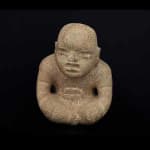Olmec Stone Sculpture of a Seated Infant, 900 BCE - 500 CE
Stone
5.125
PF.1908
Further images
Considered to be the mother culture of Mesoamerican civilizations, the Olmec ruled a vast empire covering much of southern Mexico from around 1300-400 B.C. Today, they are famed for their...
Considered to be the mother culture of Mesoamerican civilizations, the Olmec ruled a vast empire covering much of southern Mexico from around 1300-400 B.C. Today, they are famed for their colossal heads, giant sculptures that first alerted scholars to their existence in the latter half of the 19th Century. Scholars continue to debate whether these monumental sculptures depict the heads of deities, rulers and kings, or even decapitated sacrificial victims. Thus, when the meaning of the most well-known monuments of the Olmec culture is open to debate, little can be known for sure about these mysterious people. Like other great mother cultures, such as the Sumerians in Mesopotamia, the artistic and religious traditions of the Olmec were absorbed and adapted by the cultures that followed them, most notably the Mayans.
At the heart of Olmec mythology was the composite creature known as the “were-jaguar”, which was the most common subject of the art. This name is used to describe a characteristic countenance of Olmec art generally exhibiting the puffy, fat cheeks and jowls of a human baby with the slanted eyes and curved mouth of a jaguar thought by scholars to depict a shaman in the midst of transmogrification. This splendid sculpture depicts a figure seated cross-legged with hunched shoulders. In his face, we see a gorgeous representation of the “were-jaguar” type, specifically his slanted eyes and downturned mouth. He seems in some ways a child, yet in experience he seems infinitely old, possessed of primal knowledge. Might he be a shaman seated in intense meditation as he transforms from man into animal? Such a figure opens up the doors of imagination, and makes us realize that not every secret in the Universe is known to man.
At the heart of Olmec mythology was the composite creature known as the “were-jaguar”, which was the most common subject of the art. This name is used to describe a characteristic countenance of Olmec art generally exhibiting the puffy, fat cheeks and jowls of a human baby with the slanted eyes and curved mouth of a jaguar thought by scholars to depict a shaman in the midst of transmogrification. This splendid sculpture depicts a figure seated cross-legged with hunched shoulders. In his face, we see a gorgeous representation of the “were-jaguar” type, specifically his slanted eyes and downturned mouth. He seems in some ways a child, yet in experience he seems infinitely old, possessed of primal knowledge. Might he be a shaman seated in intense meditation as he transforms from man into animal? Such a figure opens up the doors of imagination, and makes us realize that not every secret in the Universe is known to man.
Literature
V6









